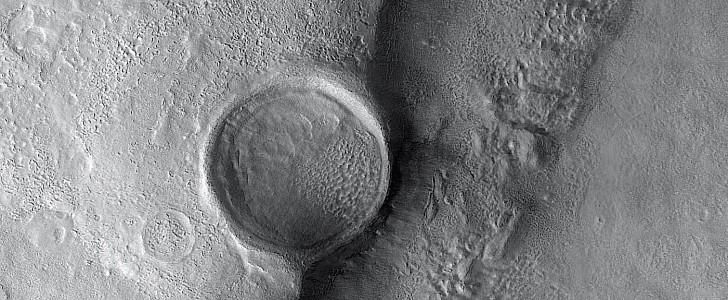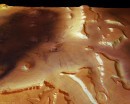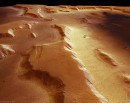It’s almost perfectly round, like most impact craters usually are. It’s located on Mars, a planet that seems to be acting as a sort of magnet for pieces of stray space rocks, hence it’s surrounded by a number of other, smaller craters. So far, nothing unusual. Except this one seems to be hanging on the edge of some cliff.
The Deuteronilus Mensae region of Mars is, if you like, the border between the crater-laden region to the south of the planet, and the plains to the north. Scientists believe the area was once home to glaciers, and may have some of the substance still, hidden from sight. It’s also home to this thing NASA and the University of Arizona scientists call a hanging crater.
It’s hard for us to wrap our heads around how such a feature came to be. Sure, it involved an asteroid impacting the surface at some point in the past, but how it ended up intact, yet seemingly half-floating over a precipice, is anybody’s guess.
The image of the crater was captured by the HiRISE camera back in 2020 from an altitude of 302 km (188 miles), but does little in the way of explaining what we’re seeing.
The people behind the HiRISE compare the crater with the Hanging Gardens in Babylon here on Earth, and even say “pictures like this will help us understand the effects of crater impacts,” but other than that we’re left with the admission that this is an “unusual view.”
The HiRISE has been orbiting the planet for 15 years now, and has sent back over 70,000 photos of the planet. We’re far from going through them all, but of the ones we did feature here in our Get to Know Mars section, this surely must the most “unusual,” to put it mildly. At least until something even more extraordinary comes along.
It’s hard for us to wrap our heads around how such a feature came to be. Sure, it involved an asteroid impacting the surface at some point in the past, but how it ended up intact, yet seemingly half-floating over a precipice, is anybody’s guess.
The image of the crater was captured by the HiRISE camera back in 2020 from an altitude of 302 km (188 miles), but does little in the way of explaining what we’re seeing.
The people behind the HiRISE compare the crater with the Hanging Gardens in Babylon here on Earth, and even say “pictures like this will help us understand the effects of crater impacts,” but other than that we’re left with the admission that this is an “unusual view.”
The HiRISE has been orbiting the planet for 15 years now, and has sent back over 70,000 photos of the planet. We’re far from going through them all, but of the ones we did feature here in our Get to Know Mars section, this surely must the most “unusual,” to put it mildly. At least until something even more extraordinary comes along.







